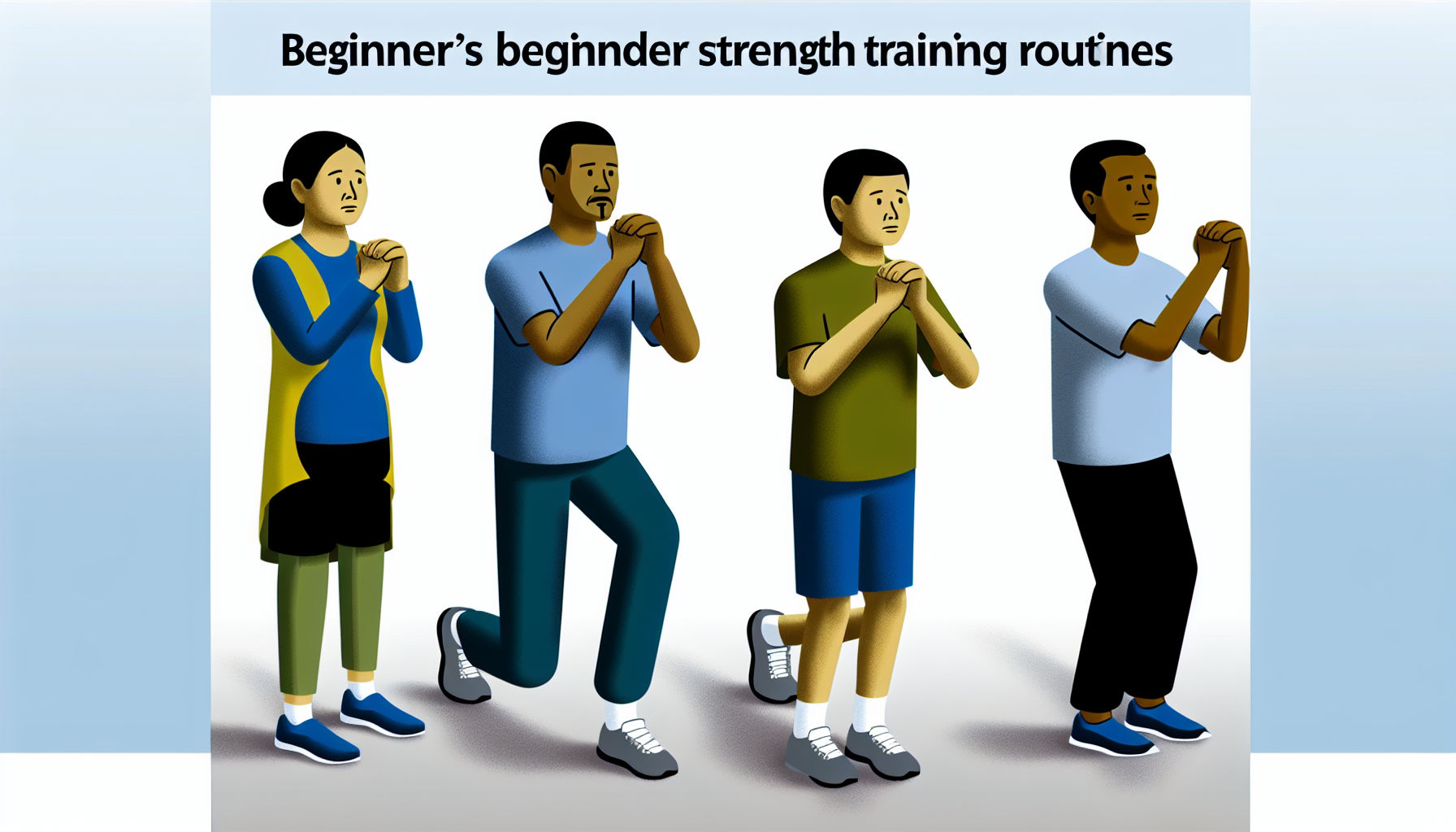
Strength training, often referred to as resistance training or weight training, is a form of physical exercise that focuses on using resistance to induce muscular contractions, thereby building strength, endurance, and muscle mass.
This type of training can be accomplished through various modalities, including free weights, resistance bands, and body-weight exercises. Historically, strength training can trace its roots back to ancient civilizations where athletes employed rudimentary weights to enhance their performance in sports and military endeavors.
Unlike aerobic exercises, which primarily aim at improving cardiovascular endurance, strength training is centered on the application of progressive resistance to increase muscle strength and size. While both forms of exercise are vital for a well-rounded fitness regimen, strength training engages different energy systems and impacts various muscle fiber types to a greater extent. When one engages in resistance training, the muscular system is subjected to stress, leading to microscopic tears in muscle fibers. The body then repairs these tears during recovery, promoting muscle growth—a process known as hypertrophy.
The physiological effects of strength training extend beyond muscle growth. Regular engagement in resistance exercises has been shown to improve metabolism, aiding in the more efficient use of energy. As muscle mass increases, so does the basal metabolic rate (BMR), meaning that more calories are burned at rest. Additionally, strength training has been associated with enhanced bone density, improved insulin sensitivity, and better overall body composition. These benefits contribute to reducing the risk of chronic diseases, such as diabetes and obesity, and are essential for maintaining functional fitness throughout one’s lifespan.
Strength training, often associated solely with bodybuilding or elite athletes, provides a wide array of benefits that can be advantageous for individuals of all ages. It is crucial to understand that engaging in regular strength training can yield significant physical improvements, including increased muscle strength, enhanced endurance, and reduced injury risk. For children and adolescents, it supports proper growth and development while promoting healthy habits early in life. As they build a foundation of strength, they may also experience improved athletic performance and enhanced self-esteem.
In adults, strength training can play a vital role in maintaining muscle mass and metabolic function. As individuals age, sarcopenia, or age-related muscle loss, becomes a concern. Regular engagement in strength training helps mitigate this decline, ensuring that adults maintain functional independence and quality of life. Additionally, it serves as an effective means for weight management, as increased muscle mass elevates resting metabolic rate, which means that even at rest, more calories are burned. This is particularly beneficial in combating obesity and related health issues.
The mental benefits of strength training are equally important. Studies have shown that engaging in regular resistance exercises can lead to improved mood and reduced levels of anxiety and depression. Physical activity, including strength training, releases endorphins—often referred to as the body’s natural mood lifters. Furthermore, accomplishing strength training goals fosters a sense of achievement, promoting a more positive self-image. Therefore, whether one is a child, an adult, or a senior, the benefits of strength training are comprehensive, encompassing both physical enhancement and significant mental health improvements. The inclusion of this vital form of exercise into daily routines can lead to transformative effects for individuals across the lifespan.
Strength training is frequently surrounded by myths that can discourage beginners from participating. One prevalent misconception is that strength training is solely for bodybuilders or athletes. In reality, strength training is beneficial for individuals of all fitness levels, including those who are seeking general health improvements or weight management. It is a versatile form of exercise that enhances muscle strength, endurance, and overall fitness, making it accessible to everyone.
Another common myth is the belief that strength training will lead to excessive muscle bulk, particularly among women. This misunderstanding stems from societal perceptions of femininity and the fear of altering one’s physical appearance. However, women typically possess lower levels of testosterone compared to men, which means they are less likely to gain significant muscle mass. Instead, strength training can help women achieve a toned appearance, improve metabolism, and support overall wellness. Emphasizing this point is crucial to alleviating the concerns many women have about incorporating strength training into their routines.
Moreover, some individuals think that strength training is unsafe for aging populations or those with existing health issues. On the contrary, when performed correctly and under professional guidance, strength training can enhance bone density, muscular strength, and functional mobility, reducing the risk of falls and injuries. This invalidation of strength training is unfounded; numerous studies have illustrated its efficacy and safety for older adults when tailored to their specific needs.
It’s essential to dispel these myths surrounding strength training to promote a broader acceptance and understanding of its benefits. By providing factual information and practical insights, individuals can feel empowered to embrace strength training and integrate it into their fitness routines, fostering a healthier lifestyle for themselves and others.
When embarking on a journey into strength training, having the right equipment can significantly enhance the experience and results. Beginners often face the challenge of selecting the appropriate tools without overwhelming choice or high costs. Fortunately, there are several essential pieces of equipment that cater to varying budgets and spatial constraints.
First and foremost, free weights are a fundamental component of strength training. Dumbbells and kettlebells are versatile options that allow for a wide range of exercises targeting various muscle groups. They come in different weights, so it’s advisable for beginners to start light and gradually increase as strength builds. For those looking to optimize costs, adjustable dumbbells are a fantastic investment as they provide a range of weights in a single unit, saving both money and space.
Another effective tool for starting strength training is resistance bands. These elastic bands offer a portable and low-cost means of performing strength exercises. Resistance bands can easily be used at home or while traveling, making them an excellent choice for individuals with limited space. They provide varying levels of resistance, which can be adjusted by changing the band or the tension applied during use.
Bodyweight exercises should not be overlooked either, as they require no equipment and can be performed anywhere. Exercises such as push-ups, squats, and lunges can effectively build strength and are ideal for beginners seeking to develop their initial fitness levels without the need for costly equipment.
When selecting the right equipment for either home or gym workouts, consider factors such as available space, budget, and your personal fitness goals. Investing in versatile and adaptive equipment will ensure a progressive and effective strength training regimen, setting the foundation for long-term fitness success.

For individuals beginning their strength training journey, establishing a structured routine is crucial for achieving desired fitness goals while minimizing the risk of injury. This section outlines several effective beginner strength training routines that can be performed in a gym or at home.
The full-body workout is an excellent choice for novices. It engages multiple muscle groups in each session. An effective routine could consist of the following exercises:
Incorporating upper and lower body splits is another effective strategy. This allows beginners to focus on specific muscle groups with sufficient recovery time. An upper body routine may include:
For the lower body, consider:
Additionally, bodyweight exercises can be a practical option for beginners without equipment. Simple movements like squats, lunges, and push-ups can be performed anywhere. A balanced routine might involve:
By following these foundational strength training routines, beginners can build strength progressively while developing proper form and technique. Consistency in training, along with gradual increases in resistance or repetitions, will lead to notable improvements in overall fitness.
When embarking on a strength training journey, safety should be your primary concern. Proper form is crucial in any exercise to prevent injuries and ensure the effectiveness of your workout. Before you begin, familiarize yourself with the correct techniques for each movement. Consider seeking guidance from a certified trainer who can provide personalized feedback on your form and posture.
Additionally, integrating a warm-up routine into your training program is essential. Warm-up exercises increase blood flow to the muscles, enhance flexibility, and prepare your body for the demands of resistance training. Simple activities such as dynamic stretches, light cardiovascular exercises, or mobility drills can adequately prepare your muscles and joints. Similarly, a cooldown routine is equally important. After your workout, spend time engaging in static stretching to promote recovery and reduce muscle soreness.
Listening to your body is vital throughout your strength training journey. If you experience pain beyond typical muscle fatigue or discomfort, it is crucial to stop the activity and assess the situation. Ignoring warning signs may lead to serious injuries. Also, understand the difference between general soreness and pain that may indicate a problem. Use your body’s feedback to guide your training decisions, and do not hesitate to rest when necessary.
When it comes to increasing weights and intensity, it is important to do so gradually. Start with lighter weights to master the form and technique before adding more resistance. A good rule of thumb is to increase the weight by no more than 5-10% per week once you feel comfortable with your current load. This gradual approach fosters a sustainable progression while minimizing the risk of injury.
Integrating strength training into your exercise regimen can be a vital step towards achieving overall fitness and well-being. To begin, it is essential to set realistic and achievable goals aligned with your personal fitness level. This might involve defining specific outcomes, such as increasing muscle strength, improving endurance, or enhancing overall body composition. By establishing measurable targets, such as lifting a specific weight for a particular number of repetitions, you can better track your progress and remain motivated.
Time management is another crucial aspect that can help in seamlessly incorporating strength training into your schedule. Begin by assessing the total time you can devote to workouts each week. Aim to allocate at least two to three days for strength training within your routine. Structuring shorter, more focused training sessions—ranging from 30 to 60 minutes—can make this feasible. Consider combining two or three major muscle groups in each session to maximize efficiency and results.
Creating a balanced workout schedule that incorporates both strength and cardiovascular training is essential for comprehensive fitness. For instance, you could dedicate specific days for strength workouts while using alternate days for cardiovascular exercises, such as jogging, cycling, or swimming. This not only allows adequate recovery for your muscles but also enhances your aerobic capacity and overall stamina. Remember that flexibility is also key; adapt your routine based on how your body feels and respond accordingly.
Incorporating proper nutrition and hydration practices further supports your strength training efforts. Ensure you’re consuming sufficient protein to facilitate muscle repair and growth, alongside other essential nutrients. By thoughtfully structuring your regimen, setting realistic goals, and maintaining flexibility with your plan, you can effectively integrate strength training into your regular exercise routine, creating a holistic approach to health and fitness.

Monitoring your progress in strength training is essential for staying motivated and ensuring that your efforts yield the desired results. There are several effective methods for tracking strength gains, each providing valuable insights into your performance and development. One of the most common approaches is to record the weights lifted during each workout. Maintaining a workout journal that details the exercises performed, the repetitions, and the weights can help you visualize your improvements over time. This method allows you to establish a baseline and compare your current performance against previous records, showcasing your advancements.
Another significant aspect of tracking progress includes observing changes in body composition. Utilizing tools such as body fat calipers, resistance scales, or even progress photos can offer a clearer picture of how your body is transforming as you engage in strength training. By measuring circumferences of various body parts, you can also evaluate changes in muscle mass and fat distribution. These measurements can serve as a motivational indicator and highlight the effectiveness of your strength training routine.
Conducting regular strength assessments is another effective method to gauge your progress. Many individuals opt for recurring tests that measure their maximum lifts for key exercises such as squats, deadlifts, or bench presses. Not only does this provide tangible evidence of your strength gains, but it can also be a source of motivation as you aim to surpass your previous records.
Beyond the numerical data, tracking progress can offer psychological benefits. Celebrating milestones, whether big or small, fosters a sense of accomplishment and boosts motivation. Acknowledging personal achievements in strength training creates a positive feedback loop, encouraging further commitment to your fitness journey. By effectively measuring your strength gains, you can adapt your training regimen, set new goals, and ultimately enjoy a more gratifying training experience.
In conclusion, strength training emerges as a vital component in any fitness regimen, offering a multitude of benefits that extend beyond mere physical appearance. Throughout this guide, we explored how engaging in strength training can enhance muscle mass, increase metabolic rate, and improve overall health. Additionally, we highlighted its positive impact on mental well-being, including boosted confidence and reduced anxiety levels.
Beginning a strength training journey may seem daunting, but the key is to start with manageable goals and gradually build your strength. Whether you choose to work out at the gym or prefer exercising at home, the essence of strength training lies in consistency and perseverance. As you embark on this transformative path, it is crucial to integrate various routines that challenge different muscle groups, ensuring a balanced approach to your workouts.
To empower your fitness journey, consider connecting with supportive communities or seeking guidance from fitness professionals who can personalize your training plan based on your specific goals and fitness level. Numerous resources are available, including online platforms, local classes, and even virtual workout sessions that foster a sense of camaraderie while pushing you toward your fitness objectives.
Ultimately, the transition into strength training should be viewed as a lifelong commitment to health and well-being rather than a temporary endeavor. Embrace the journey ahead with an open mind and a willingness to learn. The benefits of strength training are profound, not only in terms of physical strength but also in fostering resilience and empowerment in your daily life. Take that first step today, and unlock your potential through the power of strength training.
Looking to advertise, promote your brand, or explore partnership opportunities?
Reach out to us at
[email protected]
Chose where you want to study, and we will let you know with more updates.